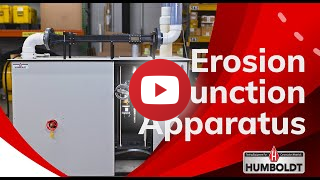The HM-5940.3F erosion function apparatus (EFA) was designed and built to prevent bridge failures by measuring the erodibility of soil. Used in conjunction with the SRICOS scour prediction method, the HM-5940 can provide more accurate erodibility measurements and scour predictions than previously obtainable. Applications for its use include: scour at bridges, piping of dams, beach erosion and surface erosion problems. In the case of scouring at bridge locations, the EFA leads to improved accuracy on scour depth predictions, offering several advantages over previous test methods. These advantages include: minimum sample disturbance; measurement of erosion rate vs. shear stress; measurement of critical shear stress, and incorporation of the test results from the SRICOS scour prediction method. The HM-4000 erosion function apparatus uses standard 3.0" OD x 2.875: ID (76.2 x 73 mm) Shelby tubes. The SRICOS method improves the accuracy of pier scour predictions. The HM-5940 EFA is designed to be used in conjunction with the SRICOS method of scour prediction. The SRICOS scour prediction method and the HM-5940 erosion function apparatus were developed through research carried out by Jean-Louis Briaud, PHD, PE. and the scour research team at the Texas Transportation Institute of the Texas A&M University System. In comparison with the HEC-18 equation (a standard for calculating scour predictions), SRICOS generally leads to smaller calculated scour depths and compares more favorably to actual measured scour depths.
- 7" touch screen interface
- Records and tabulates test data.
- Can store hundreds of tests at a time.
- Graphs flow rate vs. time as well as water temperature vs. time
- System can automatically fill the water tank using water level sensors.
- System can automatically cycle between water sump and water fill during tests to maintain lower water temps.
- If hooked up the internet then the machine will auto update with available firmware updates.
- Test data can be exported to a USB stick for transfer to a PC with Humboldt's data download software available from the Humboldt website.
- Motor can push the sample any specific distance customizable by the user.
The EFA uses either of two variants of the SRICOS method:
The Extended SRICOS Method
1) Calculate the maximum depth of scour.
2) Collect soil samples at the site.
3) Test samples in the EFA to obtain the erosion rate vs. the hydraulic shear stress applied.
4) Prepare the velocity hydrograph for the bridge.
5) Use the SRICOS program with 3 & 4 above as input and generate the depth of scour vs. time over the period covered by the chosen hydrograph.
The Simple SRICOS Method
1) Calculate the maximum depth of scour.
2) Collect soil samples at the site.
3) Test samples in the EFA to obtain the erosion rate vs. hydraulic shear stress applied.
4) Calculate the equivalent time for a given design life of the bridge and for the design velocity.
5) Using known equations, calculate the scour depth at the end of the design life.





